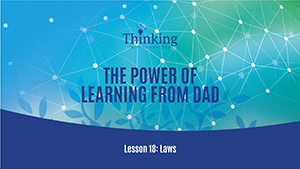Lesson 18: Laws
Lesson 18 – Laws – Part 1
Man-made laws shift from one locality or jurisdiction to another. In contrast, laws of nature are the same for everyone. In this lesson we will look at three laws of nature, originally identified by Wallis D Wattles in his book, The Science of Getting Rich. These are: The Law of Perpetual Transmutation, The Law of Relativity and The Law of Vibration.
The law of perpetual transmutation: It is by means of this law that thought energy is transformed into physical form: ideas are turned into things. The process of transmutation as we have seen involves impressing ideas into the subconscious mind and emotionalizing them in order that they may take root there. These embedded ideas, through your efforts, transmute into reality.
The law of relativity: Every evaluation we make is given meaning relative to something. There is no rich or poor, big or small until you relate it to something else. The law of relativity enables us to always find something for which we are grateful, and always have something towards which we can aim. Practice reframing so as to always see the good in your situation.
The law of vibration and attraction: The law of vibration states that everything vibrates and nothing rests. Our thoughts are vibrations. The conscious awareness of thought vibrations is what we call feelings, thus when I say I feel good or bad, I am really saying that I am in a positive or a negative vibration. The law of attraction says that the vibrations produced by our thinking attract their correlates in reality. Angry thoughts will be experienced as angry feelings, and will attract situations that make us angry.
Lesson 18 – Laws – Part 2
The discussion of the laws on nature continues here. In this lesson, we are introduced to the following laws of nature: The Law of Polarity, The Law of Rhythm, The Law of Cause and Effect and The Law of Gender.
The Law of polarity: This law states that everything in the universe has its opposite. There is good and bad, inside and outside, rich and poor. Which of the opposite we focus on will depend on the framing provided by the law of relativity. One interesting observation made here is that, generally, when there is a little bad in a situation, there is corresponding only a little good to be garnered from it. Thus it is usually when going through the worst of times that the greatest opportunities can be found.
The law of rhythm: This law states that everything is in movement or in a state of flow. The planets move around the sun, the tides go in and out, a person moves from consciousness to sleep states and back again and so on. This law means that there will be times when we are up, and times when we are down, that is flow. Indeed it is the down times that gives most meaning to and enables us to recognise the good times.
The law of cause and effect: This is the law of laws because it is the law governing all of our results. In order to get the results that we want, we must focus on the causes of the results we desire, and let the results take care of themselves. Often time when we are unhappy with a situation we fixate on the situation – however the situation is an effect. We have no control over effects, only causes. To get new result we must focus on the cause of the new results that we seek to achieve.
The law of gender: The law of gender manifests itself in all things. It is the masculine and feminine principle. In the animal kingdom, the law of gender manifests itself in the creation of families. The law of gender also manifests in the mineral and vegetable kingdoms, where without the duel principles of male and female in all things, there could be no regeneration.

